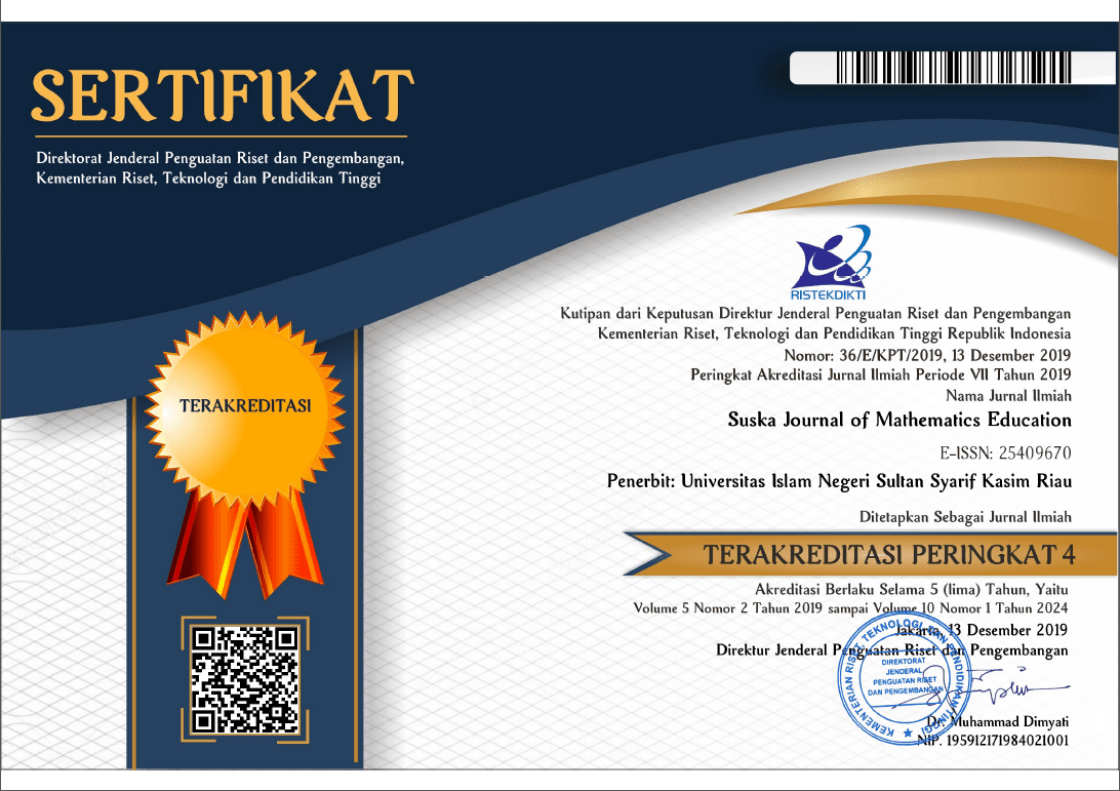KUALITAS HASIL BELAJAR STATISTIKA SISWA MTs YANG DIBELAJARKAN DENGAN PENDEKATAN PROBLEM POSING
Abstract
Keywords
Full Text:
PDFReferences
Afriansyah, E. A. (2017). Problem Posing sebagai Kemampuan Matematis. Mosharafa: Jurnal Pendidikan Matematika, Vol. 6, No. 1, pp. 163–180. [online]. Tersedia:
https://journal.institutpendidikan.ac.id/index.php/mosharafa/article/view/mv6n1_15/308
Ahmad, Zainal Arifin. (2012). Perencanaan Pembelajaran dari Desain sampai Implementasi. Yogyakarta: Pedagogia.
Asterius Juano, Pardjono. (2016). Pengaruh Pembelajaran Problem Posing Terhadap Kemampuan Berpikir Kritis dan Komunikasi Matematis Siswa Kelas V SD. Jurnal Prima Edukasia, Vol. 4, No. 1, pp. 46-53. [online]. Tersedia: http://journal.uny.ac.id/index.php/jpe/article/view/7801/pdf
BNSP Kemendikbud. (2015). Data Hasil Ujian Nasional Tahun Pelajaran 2014/215. [online]. Tersedia: http://bsnp-indonesia.org
Brown, S. I. & Walter, M. I. (2005). The Art of Problem Posing. (3rd ed.). Mahwah, New Jersey: Lawrence Erlbaum Associates, Inc., Publishers. [online]. Tersedia: https://www.taylorfrancis.com/books/9781135612245
Dewi Daryati, Nugraha, Nani Sutarni. (2018).Pengaruh Penggunaan Metode Problem Posing terhadap Kemampuan Memecahkan Masalah. Jurnal Pendidikan Ilmu Sosial. Vol. 27, No. 1, pp. 31-42. [online]. Tersedia: http://ejournal.upi.edu/index.php/jpis/article/view/11048
Elif Esra Arıkan, Hasan Ünal. (2015). An Investigation of Eighth Grade Students’ Problem Posing Skills (Turkey Sample). International Journal of Research in Education and Science (IJRES), 1(1), 23-30. [online]. Tersedia: https://files.eric.ed.gov/fulltext/ED548490.pdf
Hayrettin Ergün. (2010). The Effect of Problem Posing on Problem Solving in Introductory Physics Course. Journal of Naval Science and Engineering 2010, Vol. 6 , No.3 , pp. 1-10. [online]. Tersedia: http://www.dergipark.gov.tr/download/article-file/105325
Hudojo, Herman. (1990). Strategi Belajar Mengajar Matematika, Cetakan II. Malang: IKIP Malang.
Işik, C., Kar, T., Yalçin, T., & Zehir, K. (2011). Prospective Teachers’ Skills In Problem Posing With Regard To Different Problem Posing Models. In Procedia- Social and Behavioral Sciences. Vol. 15, pp. 485–489. [online]. Tersedia: https://doi.org/10.1016/j.sbspro.2011.03.127
Kardi, S. dan Nur, M. (2000). Pengajaran Langsung. Surabaya : University Press.
Muhammad Thobroni dkk. (2013). Belajar & Pembelajaran Pengembangan Wacana dan Praktek Pembelajaran dalam Pembangunan Nasional. Jogjakarta: Ar-Ruzz Media.
Muhammad Win Afgani, Bagus Ardi Saputro, Jero Budi Darmayasa. (2016). Pembelajaran Matematika Menggunakan Pendekatan Problem Posing Berbasis Komputer Pada Siswa SMA Kelas X. Infinity: Jurnal Ilmiah Program Studi Matematika STKIP Siliwangi Bandung, Vol. 5, No. 1, pp. 32-41. [online]. Tersedia: http://e-journal.stkipsiliwangi.ac.id/index.php/infinity/article/view/189
Pittalis, M., et al. (2004). A Structural Model for Problem Posing. Proceedings of The 28th Conference of the International Group for The Psychology of Mathematics Education, 4, 49-56. [online].
Tersedia: http://ww.kurims.kyoto-u.ac.jp/EMIS/.../RR/RR058_Pittalis.pdf
Purwanto. (2009). Evaluasi Hasil Belajar. Yogyakarta: Pustaka Pelajar.
Robert M. Gagne, Leslie J. Briggs and Walter W. Wagner. (1979). Principles of Instructional Design. New York: Holt, Rinehart and Winston. [online]. Tersedia: https://hcs64.com/files/Principles%20of%20instructional%20design.pdf
Rosli, Roslinda Goldsby, Dianne Capraro, Mary Margaret. (2013). Assessing Students' Mathematical Problem-Solving And Problem-Posing Skills. Asian Social Science, Vol. 9, No. 16, pp. 54-60. [online]. Tersedia: http://dx.doi.org/10.5539/ass.v9n16p54
Russeffendi. (2005). Dasar-Dasar Matematika. Bandung: Tarsito.
Schunk, Dale H. (2012). Learning Theories an Educational Perspective, Edisi Keenam, Penterjemah Eva Hamdiah dan Rahmat Fajar, Yogyakarta: Pustaka Pelajar.
Silver, E. A. & Cai, J. (1996). An analysis of arithmetic problem posing by middle school students. Journal for Research in Mathematics Education, Vol. 27, No. 5, pp. 521-539. [online]. Tersedia: https://www.jstor.org/stable/749846
Sudjana, Nana. (199). Penilaian Hasil Proses Belajar Mengajar. Bandung: PT Remaja Rosdakarya.
Sukardi. (2004). Metodologi Penelitian: Kompetensi dan Prakteknya. Jakarta: Bumi Aksara.
Sunarto dan B. Agung Hartono. (2006). Perkembangan Peserta Didik. Jakarta: PT Rineka Cipta.
Syaiful B. Djamarah dan Aswan (2002). Strategi Belajar Mengajar. Jakarta: Rineka Cipta.
Walpole, R.E. (1992). Pengantar Statistika. Jakarta: PT Gramedia Pustaka Utama.
DOI: http://dx.doi.org/10.24014/sjme.v4i2.5744
Refbacks
- There are currently no refbacks.

This work is licensed under a Creative Commons Attribution-NonCommercial-ShareAlike 4.0 International License.
Published by:
![]()
FLAG COUNTER






